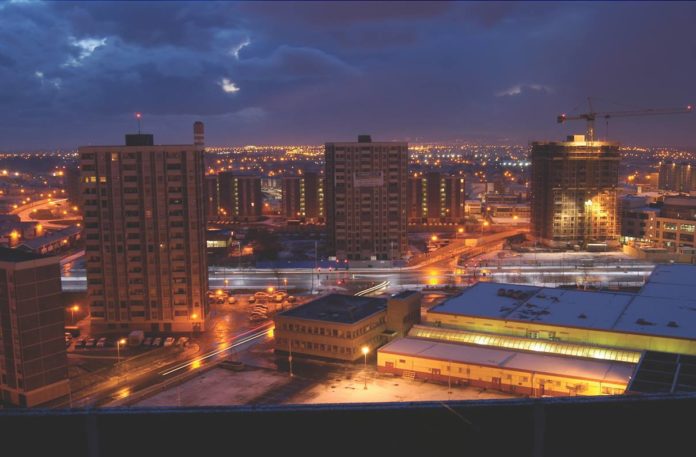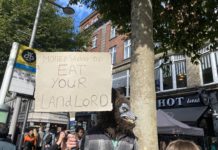In 2016, producer Andrew Keogh and I set out to document the impact of the Irish state’s twenty-year “regeneration” of Ballymun, the iconic high-rise suburb on Dublin’s northern fringe. What we found was a community in a state of social shock.
The regeneration had been hailed as a consultative process, designed to reverse decades of neglect. How had a community’s pleas for redress and recognition been so thoroughly mangled? How had Ballymun Regeneration Limited (BRL), the subsidiary of Dublin City Council which oversaw the process, got it so catastrophically wrong?
Some of the answers to those questions are to be found in our completed film (The 4th Act, Bread & Circus Productions, 2016). But a thorough understanding must begin at the beginning, with the construction of the Ballymun housing complex in the late 1960s.

The popular narrative, propounded by today’s politicians and planners, runs something like this: Ballymun was a knee-jerk response to Dublin’s housing crisis of the 1960s, based on a fashionable belief in high-rise living and large-scale state intervention. It failed because its people, taking their cue from their surroundings, lacked the wherewithal to wean themselves off dependence on the state and take responsibility for their lives.
The result, so the narrative runs, was a community ravaged by poverty, addiction and violence, unfit for the modern world.
This image of Ballymun and Ballymunners is one which I, as someone who grew up there, simply do not recognise. Ultimately, however, it was this crass, ideological caricature, and not the reality, which informed BRL’s thinking.
Where BRL saw, and admonished, an “inward-looking” community, residents saw a sprawling network of collective support and organisation; what BRL’s planners saw as expanses of wasted green space, residents had made their childhood Wembleys, their Phoenix Parks, their country retreats.
Ballymun’s experience at the sharp end of “regeneration” was unique. For a variety of reasons – some political, some economic – Dublin City Council’s preferred method for liquidating communities (disperse, demolish, dispose, gentrify) could not be implemented there. Instead, something far more insidious but no less destructive was attempted – an internal gentrification of the residents themselves.
The demolition of the tower-blocks – barely maintained by the council, though mostly sound and spacious in and of themselves – was only one front in this onslaught on Ballymun’s identity. As the angular shadows of the flats disappeared from the landscape – to take up permanent residence in the nightmares of neoliberal planners – Ballymun was rebuilt according to a new gospel.

This doctrine, imported (along with some of its leading apostles) from Blair’s Britain, stressed the importance of “defensible space”: those places that encouraged suspicion of outsiders and a near-paranoiac emphasis on privacy.
The Ballymun I remember – a concrete symphony of epic scale, of swooping heights and spectacular vantage points, soothed by long pauses of green grass – was, to BRL, a scar on the landscape. With thousands of others, I watched it tumble and crumble around me over the course of two decades, in an endless, deadening pageant of loss.
But it’s the parallel process – the one that sought to re-make Ballymunners after the virtuous self-image of the Irish middle class – that haunts me now. Culture was its vanguard; one landmark artistic project, funded lavishly by BRL, encouraged residents to pay to have trees planted in their honour. The artist saw this as a means for Ballymunners to take a stake in their community; a stake that 30 years of struggle and sacrifice apparently hadn’t afforded them.
Ballymun’s vast network of community organisations was corralled and subsumed into a BRL-funded “Ballymun Neighbourhood Council”, which was itself dissolved within a few years, taking several generations of advocates and activists with it.
The private-sector investment on which BRL had bet the farm never materialised; it was not until 2020 that a solitary Lidl replaced the beloved shopping centre, as an appendage to new student accommodation.
Today, Ballymun stands as a testament to the brutal, Varadkarian logic of Ireland in 2021. Its people have been weighed in the balance and found wanting by the market. They live, according to this circular logic, in a purgatory of their making; after all, if they deserved civic amenities, or shops, or cultural spaces, the market would have provided them.
This thinking, dominant among the upper echelons of Dublin City Council, is now the state religion which governs our lives. It has locked the city into a death spiral of steepling rents, shrivelling public spaces, and a civic nihilism which has no endpoint other than the total destruction of all forms of social intercourse.
The death agony of Ballymun does not, sadly, provide any clues as to how we might reverse this process. But it does indicate that we should view our city fathers as they view us; as hostile antagonists with whom no compromise is possible.





